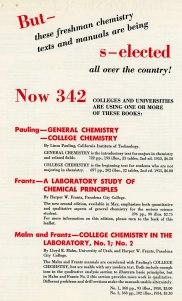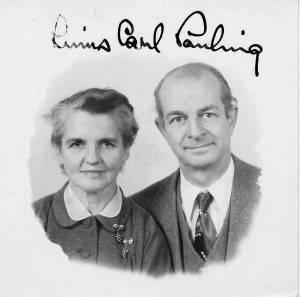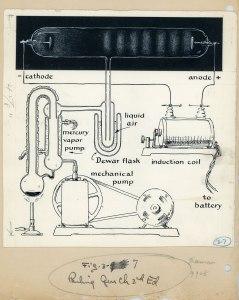
[An examination of General Chemistry, published by Linus Pauling seventy years ago. This is part 4 of 7.]
Linus Pauling and his publisher, William H. Freeman, were in the planning stages for a second edition of General Chemistry before the first edition had even hit the bookstores in 1947. Nonetheless, the second edition didn’t appear until 1953. Because so many reviewers had taken issue with the advanced nature of General Chemistry, Pauling made the decision to author an entirely different textbook, College Chemistry, which would be written for and marketed to introductory college classes and advanced high school students. Published in 1950, College Chemistry proved to be less controversial with its reviewers than was the first edition of General Chemistry, as it more closely followed the standard conventions that one might expect of an introductory textbook.
This favorable response pleased Pauling, Freeman, and Roger Hayward, who had provided the illustrations again, but it also drew significant time and attention away from progress on the second edition of General Chemistry. The trio had originally planned to have their revision out by spring 1950, but the deadline was continually pushed back as Pauling grew increasingly busy with travel and work on College Chemistry. With the initial goal of spring 1950 turning into winter of 1951 and then spring of 1952, a final hard deadline of January 1953 was ultimately issued by Bill Freeman. At long last, the second edition that the three men had been dreaming about since 1948 finally entered the world’s classrooms in September 1953.

Ava Helen and Linus Pauling’s passport photo. 1953.
While College Chemistry may have been the main culprit behind the delays that hampered the second edition, it wasn’t the only factor. More than anything, Linus Pauling was just busy, and in new ways. Most notably, in addition to his teaching, his research, and his work on two textbooks, the pace of Pauling’s political work had picked up significantly.
A forceful and sometimes isolated voice during the era of the Red Scare, Pauling was castigated for his beliefs by the mainstream media and persecuted by his government as well. In 1952, Pauling was famously denied passport clearance to leave the country, casting him and Ava Helen into a world of sudden uncertainty. Although he was eventually granted the right to travel in time to leave for a planned trip to Oxford, the experience caused a great deal of stress and distraction to say the least. In fact, Pauling made note of editing galley proofs of the second edition at JFK airport just before he and Ava Helen departed. And while there was some concern that Pauling’s beliefs might affect his sales, any dip of this sort does not appear to have come about. One reviewer went so far as to write Pauling directly to commend his political activism.
Between 1947 and 1953, with the second edition delayed again and again, the Freeman company released several revised printings of the first edition that corrected minor typographical and numerical errors, but did not change the content itself. In this, both author and publisher were signaling their intent to seriously consider reviewer comments and to continually improve the book. Ava Helen Pauling helped immensely in this regard, handling many of the error corrections from home so that her husband could focus on other projects.
That said, this revision process was not without its issues. Most notably, at one point Bill Freeman was compelled to inform his author that the projected cost for plate changes that Pauling had ordered was going to approximate the total profits that had, so far, been accrued by both General Chemistry and College Chemistry combined. Noting this, he urged Pauling to go back through his manuscript and revoke any changes that were not strictly typographical or related to errors in fact. Pauling quickly agreed, admitting that he had requested edits in any instance where felt that the style of his book could be improved, as well as the technical content.

Once it became available, reviewers of the second edition of General Chemistry noticed right away that it differed from the first edition significantly. Responding to some of the more consistent concerns expressed about the first edition, Pauling expanded his chapters on gas law, organic chemistry, and atomic physics, as well as his treatment of metals. He also added two chapters, “The Electron and the Nucleus” and “Quantum Theory and Molecular Structure.” Roger Hayward was once again enlisted to improve old illustrations and to add several new ones.
Reviewer Stanley Bruce was among those who were struck by Pauling’s fine-tuning.
I was particularly interested to note the order of presentation of topic, the deletion of much of the less important factual material on organic chemistry, the inclusion of certain topics in physical chemistry…the refined discussion of some topics…and the important emphasis on structural chemistry.
Indeed, commenters typically appreciated that Pauling had included more discussion to support his claims and had incorporated deeper analyses of modern theories. The second edition also contained a great many clarifications of terms that users of the first edition had found confusing.
On the downside, Pauling’s attempts to improve the accessibility of his text for a more introductory audience seems to have created problems with consistency. One reviewer commented that “Pauling seems to vacillate between highly technical language (which is above our students’ heads) and simplified language which seems to me inaccurate.” Another accused Pauling of mixing high school-level concepts with Ph.D.-level treatments.
In the main however, feedback for the second edition was overwhelmingly positive. Generally speaking, the novel treatment of subjects that had proven so enticing in the first edition once again won out over complaints about the organization or rigor of the book. One reviewer gushed that Pauling’s “Words flow like water down the Madison – sure, forceful, and effortless.” Though a few colleagues continued to grumble over Pauling’s selection of theories, the consensus was that the second edition marked “the end of purely descriptive chemistry.”
Meanwhile, thanks largely to the success of General Chemistry, Freeman and Co. was doing well. Buoyed by his early successes, Bill Freeman expanded his staff, hiring Theodore McClintock and Stanley Schaefer to serve as the firm’s primary editors. Schaefer in particular proved to be a crucial hire. Eventually he became president of the company and he later served as chairman of the board of directors following Freeman & Co.’s corporate merge with Scientific American in 1964.
Advertisements &b; &b;